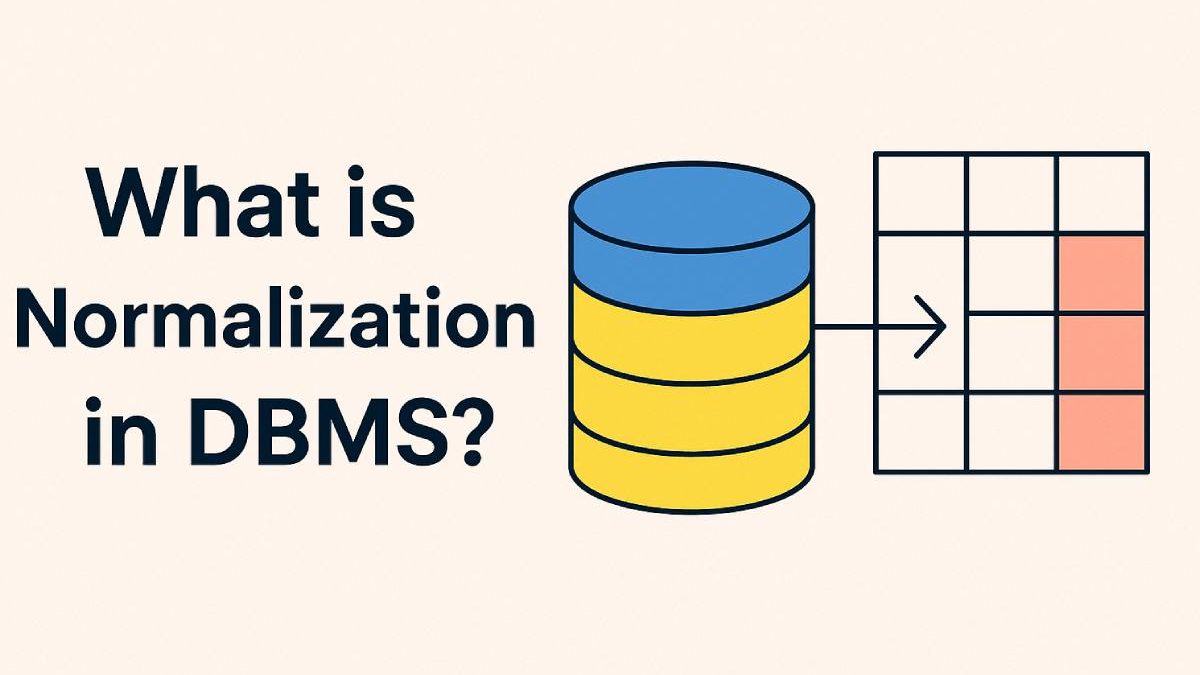What is normalization in DBMS? Look, I’m gonna be straight with you – when I first heard this term, I thought it was some fancy academic nonsense. Boy, was I wrong? After dealing with messy databases for the past decade, I can tell you normalization is the difference between a database that works smoothly and one that makes you want to pull your hair out.
Table of Contents
ToggleThe Real Deal on Database Normalization
So, what exactly is database normalization? Picture your garage after years of just throwing stuff in there. You’ve got three different hammers and old paint cans scattered everywhere, and you can never find what you need. Database normalization is like finally organizing that garage – getting rid of duplicates and putting everything in its proper place.
The technical definition? It involves organising data to reduce redundancy and enhance integrity. But here’s what that means in the real world: no more updating the same customer’s address in twelve different places, no more wondering why your sales reports don’t match your inventory counts, and no more late nights fixing data that got corrupted because someone changed something in the wrong spot.
Why This Stuff Actually Matters
Three years ago, I took over a project where the previous developer had basically ignored normalization completely. The main customer table had 47 columns. Forty-seven! Every time someone placed an order, they’d copy the customer info directly into the order table. When customers moved or changed their email, half the records got updated and half didn’t.
The result? We had customers showing up multiple times in reports, orders getting shipped to old addresses, and the marketing team constantly complaining about bounced emails. It was a nightmare.
Here’s what proper normalization saves you from:
- Duplicate data everywhere – seriously, it’s like a virus that spreads
- Update headaches – change something once, not fifty times
- Weird data inconsistencies – when John Smith becomes Jon Smith in some tables
- Storage bloat – why store the same thing a hundred times?
The Normal Forms (Don’t Worry, It’s Not That Scary)
First Normal Form: Just Get Your Data to Behave
First Normal Form is pretty straightforward. Your table needs to have:
- One value per cell (no cramming multiple phone numbers into one field)
- No repeating columns (like Phone1, Phone2, Phone3)
- Each row needs to be unique
I remember working with a client who had a “colors” field that looked like this: “red, blue, green, yellow, orange.” Every time they wanted to search for products in blue, they had to do some weird text matching. We split that into separate rows, and suddenly their search function actually worked.
Second Normal Form: Getting Rid of Weird Dependencies
This one’s about making sure all your non-key data depends on the whole primary key, not just part of it.
Here’s where I see people mess up constantly: they’ll have an order table with OrderID and ProductID as the primary key, but then they’ll stick the customer’s name in there too. Problem is, the customer name depends on the order, not the product. That’s a partial dependency, and it’ll bite you later.
Third Normal Form: No More Domino Effects
Third Normal Form eliminates what we call transitive dependencies. Basically, if A determines B, and B determines C, then you shouldn’t store C with A.
I had a database where they stored customer city and state in the same table. But here’s the thing – if you know the city, you know the state. So when someone misspelled “Chicago” as “Chicaggo,” suddenly Illinois became “Illinios” too. One typo, multiple problems.
Boyce-Codd Normal Form: For the Perfectionists
BCNF is like 3NF’s picky older sibling. Most of the time, getting to 3NF is enough. But sometimes you’ve got these overlapping candidate keys that create weird situations. It’s not something you’ll run into daily, but when you do, BCNF saves the day.
Fourth Normal Form (4NF): Tackling Multi-Valued Dependencies
Now we’re getting into the advanced stuff. 4NF deals with multi-valued dependencies – situations where one attribute determines multiple independent sets of values.
I ran into this once with a database tracking employees, their skills, and their languages. An employee could have multiple skills AND speak multiple languages, but these were completely independent of each other. Storing them in one table created unnecessary combinations and redundancy.
Fifth Normal Form (5NF): The Final Boss
5NF eliminates join dependencies. Honestly, I’ve only needed to go this far maybe twice in my career. It’s about breaking down tables that can be reconstructed by joining smaller tables without losing information. Unless you’re dealing with really complex many-to-many relationships, you probably won’t need this.
Domain-Key Normal Form (DKNF): The Theoretical Peak
DKNF is the ultimate goal – a table where every constraint is a logical consequence of domain constraints and key constraints. It’s more of a theoretical concept than something you’ll implement in practice. If you ever achieve DKNF, you’ve basically eliminated all possible anomalies, but the complexity usually isn’t worth it for real-world applications.
How I Actually Do This in Real Life
When I’m normalizing a database, I don’t just dive into the theory. Here’s my actual process:
- I draw everything out first – seriously, grab a whiteboard and map out your entities
- Start with the mess – take your current structure, warts and all
- Spot the repeating stuff – everywhere you see the same data, that’s a red flag
- Split things up gradually – don’t try to go from chaos to perfect in one step
- Test with real data – theory is great, but real data is messy
When Breaking the Rules Makes Sense
Here’s something they don’t teach you in school: sometimes you need to break normalization rules on purpose. It’s called denormalization, and it’s not cheating – it’s strategic.
I worked on a reporting system where users needed to see customer orders with full address details. Following strict normalization, that would require joining five tables for every query. The reports were taking forever to load. So we denormalized some of the address data specifically for reporting. Performance went from 30 seconds to 2 seconds.
The key is knowing why you’re breaking the rules and being intentional about it.
Database Horror Stories (And How to Avoid Them)
The Case of the Disappearing Customers: A client had a system where deleting an order would somehow make the customer vanish from other reports. Turns out, customer data was only stored in the order table. When the order went away, so did the customer. Proper normalization would’ve prevented this.
The Inventory Nightmare: Another database had product information scattered across six different tables. When they needed to update a product description, they had to remember to update it in all six places. They usually forgot at least two.
The Performance Panic: On the flip side, I’ve seen databases so normalized that simple queries required joining fifteen tables. Sometimes you need to find the sweet spot between perfect normalization and reasonable performance.
Making It Work in the Real World
The truth is, most databases aren’t perfectly normalized, and that’s okay. The goal isn’t to follow rules blindly – it’s to build something that works for your specific situation.
Here’s what I’ve learned works best:
- Start normalized – it’s easier to denormalize later than to normalize a mess
- Know your queries – understand how your data will be used before you design
- Document your decisions – six months from now, you’ll forget why you did something
- Test with real data volumes – 100 rows behave differently than 100,000 rows
- Plan for change – your requirements will evolve, and your database should too
The Bottom Line
What is normalization in DBMS? It’s your insurance policy against data chaos. It’s not about following academic rules – it’s about building databases that don’t make you want to quit your job.
Yes, it takes some upfront thinking. Yes, it might seem like overkill for small projects. But trust me, I’ve cleaned up enough database disasters to know that a little normalization goes a long way.
Start with the basics, understand why the rules exist, and then make smart decisions about when to follow them and when to break them. Your future self (and anyone else who has to work with your database) will thank you for it.
After all these years working with databases, I can tell you that normalization isn’t just a technical concept – it’s the foundation of databases that actually work in the real world.
Also Read: What is Kafka Used For: A Complete Guide
Shashi Teja
Related posts
Hot Topics
Simple Yet Effective Ways to Grow Spotify Followers Without Burning Out
It’s hard to get a break on Spotify, especially when you’re spinning plates the making music for promotion as you…
IoT Security For 2025 and Beyond – Protecting a Hyperconnected World
The internet of things(IoT), once a scattered idea of smart fridges and connected watches, has grown into a gigantic mesh…



